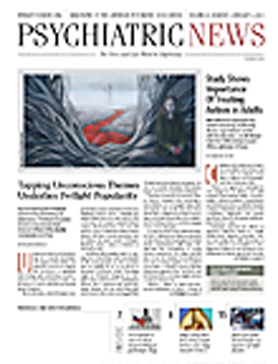Children with autism grow up to become adults with autism, and more must be learned about their condition and treatment, said Eric Hollander, M.D.
“There is no approved treatment for core symptoms in autism, and little work has been done in adults,” said Hollander, a clinical professor of psychiatry and behavioral science at Albert Einstein College of Medicine and director of the Compulsive, Impulsive, and Autism Spectrum Disorder Program at Montefiore Medical Center.
Hollander reported the effects on repetitive behaviors found in a small, double-blind, placebo-controlled clinical trial using the SSRI fluoxetine in AJP in Advance on December 2, 2011. Repetitive behaviors are among the core symptoms of autism spectrum disorder and include repeating rituals, arranging things, perfectionism, rigidity, finger picking or nail biting, and the need to adhere to strict schedules and routines.
Adults with autism spectrum disorder are valuable subjects for study because they can report what is distressing to them, said Edwin Cook, M.D., a professor of psychiatry and director of autism and genetics at the Institute for Juvenile Research at the University of Illinois at Chicago.
“They can say, ‘I’m the person with the disorder, and these symptoms feel intrusive, not like me,’” said Cook, who was not involved in Hollander’s research. “With kids, evaluation of the patient is complicated by the reports of parents who are also upset or distressed about their child.”
A previous double-blind, placebo-controlled trial using fluvoxamine in adults reduced repetitive behaviors. A trial of citalopram in children and adolescents with an autism spectrum disorder, however, found no difference in outcome between the drug and placebo.
Hollander and colleagues included data from 34 patients with DSM-IV criteria for an autism spectrum disorder who had been randomized to . Maximum dose of fluoxetine was 80 mg/day, and the mean dose was 65 mg/day.
Evaluation was by independent raters using the compulsion subscale of the Yale-Brown Obsessive-Compulsive Scale.
The researchers also looked at results on the Clinical Global Impression (CGI) scale. When an independent rater used the CGI, results were not statistically significant,fluoxetine or placebo although patients did show global improvement and fewer OCD symptoms.
The difference between the two rating systems for the CGI may reflect the fact that the clinicians considered physical, social, and quality-of-life changes, as well just scores on the test, said the researchers.
“I’d be concerned if the outcomes went in different directions, but they all point in the same direction,” noted Cook in an interview.
Overall, the outcome suggests the value in treating adults as well as children with autism spectrum disorders.
“Many people trying to deal with autism believe that you have to intervene early on or it gets fixed in place,” said Hollander. “This study shows that you can intervene in adulthood and get meaningful improvement.”
This small, single-site trial must be replicated in multisite studies in a larger sample, he pointed out.
And stratification by severity will be important for successful therapeutic trials, Hollander said. “Not all patients with autism are the same. Some do and some don’t have routine, ritual behaviors.”
Future studies that stratify patients with repetitive behaviors that lead to irritability or stress on the family should result in a bigger separation between drug and placebo effects, he said.
There are advantages to working with adults, Hollander noted. They are higher functioning, have better verbal skills, and can give informed consent.
In addition, therapeutic advances typically start with investigations of novel compounds in adults, and then, if efficacy is demonstrated, are studied in children, he said. Repetitive behavior is a reasonable target, since a number of drugs for OCD have already laid out a clear-cut regulatory pathway to Food and Drug Administration approval for drugs to treat repetitive behavior.
